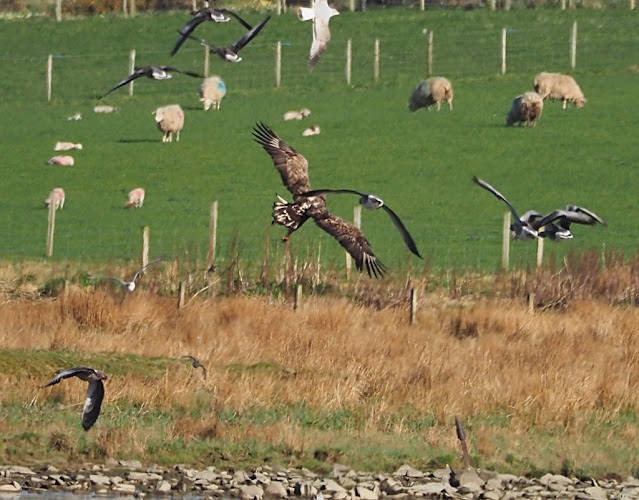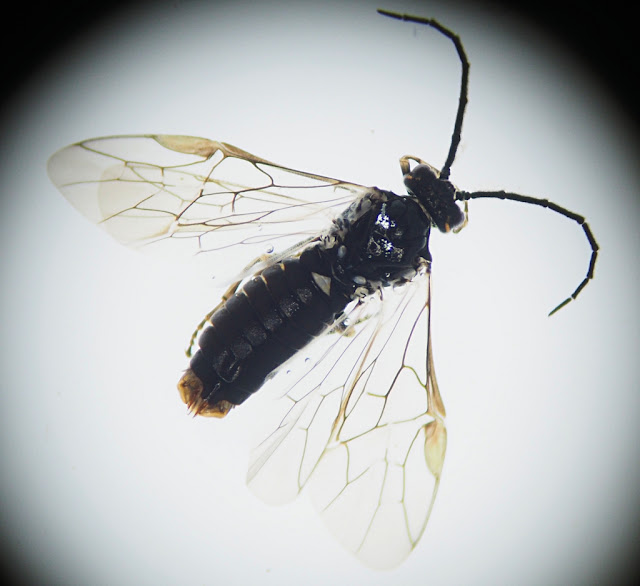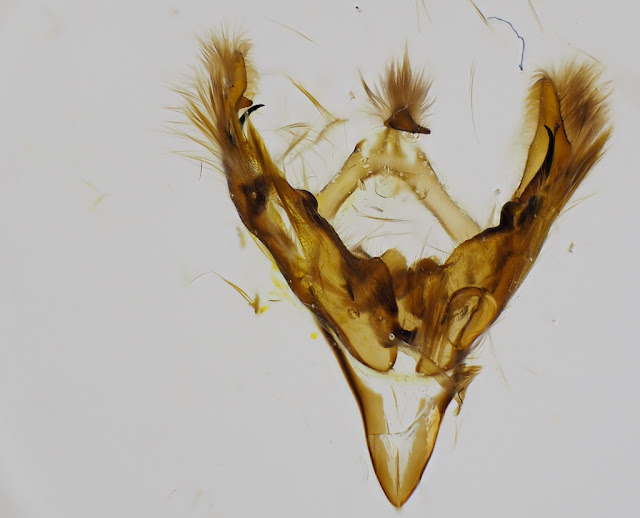This could be the penultimate post, not of the blog, I hasten to add, but of Literate Herring This Way being based in Orkney. Hopefully, we're twelve days from sailing south, permanently. The house is littered with packed and semi-packed boxes and things. Large and important things, like the piano, have been sold. Many trips to charity shops and the tip have been taken. My trailer will be the next to go.
 |
Make me an offer.... Gone..... I'm sad to see it go.
|
Quite sad to let it go but I won't need it and it will take up parking space unnecessarily. It's a bit knackered, with a bit of the floor broken, but it's not let me down, only jumping off the hitch once, which was a tad scary.
The other week BH and I had another roam around his garden on Burray during which we found two or three species of beetle that were second records for the county, I got at least three lifers, two beetles and a bug. It took a while to sort everything out of course, the usual two hours in the field = ten hours in the "lab" (otherwise known as a kitchen). Many things were photographed so that the records could be proven. My personal highlights were Philonthus decorus, many thanks to AKH for his help with the identification, and Phaedon tumidulus, which BH had previously found just a few weeks earlier. Otiorhynchus porcatus, Cercyon littoralis, Atomaria nitidulus and Leiosoma deflexum were the other beetle species we found that are not ones I see too frequently.
 |
Philonthus decorus, a female, so no genitalia images but a definite ID thanks to AKH.
|
 |
Phaedon tumidulis
|
The rough grassland and inter-tidal zone at Westshore seems to be a particularly good place for beetles in Orkney. Quite a few local "rarities" have been found there.
We found quite a few more common things as well, a nice Phosphuga atrata, always welcome; Small Tortoiseshell and there were some slugs photographed which I haven't got around to yet.
 |
Phosphuga atrata, a predator of snails.
|
 |
Small Tortoiseshell, my first free-flying one of the year; there had been one we found in the garage previously.
|
We'd wandered around with the EMP lure all morning, but no takers there. I got home, leaving the bag the lure had been in the garage and an Emperor Moth appeared quite promptly. And then another Small Tortoiseshell as well, it was a fine day.
It's been a good time for beetles with a trip to a certain location producing unexpected, due to the early date, plenty, in the form of seven Prasocuris hannoveriana on one plant, six of these were pairs in cop. UK wide this is a very uncommon beetle with a weird distribution. There are possibly three sites in Orkney. I've searched many other places and failed, the food plant is Marsh Marigold.
 |
| Prasocuris hannoveriana |
Another fine day and Louise and I walked out on to The Brough of Birsay. There were Wheatears and there were Fulmars.
 |
Wheatear, female.
|
 |
| Fulmars. |
Around The Shunan there have been Swallows a couple of times, and most extraordinarily a White-tailed Eagle, on the deck, which went paddling. The photos are rubbish as it flew and mostly kept it's back to me but an extraordinary record.
 |
White-tailed Eagle, sub-adult.
|
In the last week there have been Brambling, 3+; Siskin, 3+, Chaffinch, 2+, Chiffchaff, one singing, Swallow, a couple today around the house and garden. Hard to match the excitement of the Great Tit!
 |
Brambling, male.
|
Most exciting have been the sawflies I've been finding. So far I've (with considerable help, thanks JS, AG, IA and AM) only identified two of these, and one of these two is somewhat pending, as it has not been confirmed. The specimens will be handed to JS shortly. There are very few records of Dolerus coracinus in the UK (I've previously posted about this one). But then I found two others, one looks to be coming out as Euura clitellatus. Having just found images of this species on the Sawflies UK website, of a male, I'd thought there were only images of the female, I'm considerably more confident about the ID.
 |
8th tergite, post dissection.
|
 |
8th tergite before dissection.
|
 |
Penis valve.
|
 |
Euura clitellatus, a male.
|
In the garden yesterday I did find Syrphus torvus whilst mowing the grass, it settled on the fuel can.
 |
Although it's a female you can see the eye hairs quite clearly, Syrphus torvus.
|
Today a stroll around Birsay Links and the cliffs towards Marwick. Disappointingly the cliffs where I sometimes photograph auks were bare. However, the Links beach was a tad more rewarding with four monstrous Broscus cephalotes (and another carabid I need to ID).
 |
Broscus cephalotes.
|
Also on the beach this head and neck which are I think of Conger Eel. Re-identified, after a bit of research this is a Ling, Molva molva. The head was about 150mm long.
 |
Conger I think. A check and it is Ling Molva molva.
|
 |
The Brough of Birsay.
|


















































